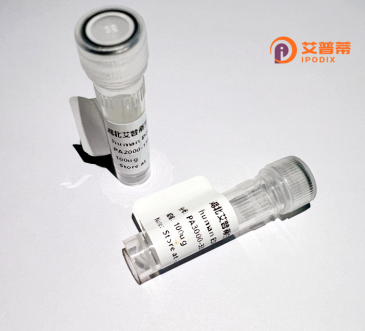
| 纯度 | >90%SDS-PAGE. |
| 种属 | Human |
| 靶点 | SET7 |
| Uniprot No | Q8WTS6 |
| 内毒素 | < 0.01EU/μg |
| 表达宿主 | E.coli |
| 表达区间 | 110--366 aa |
| 活性数据 | YKDNIRHGVCWIYYPDGGSLVGEVNEDGEMTGEKIAYVYPDERTALYGKFIDGEMIEGKLATLMSTEEGRPHFELMPGNSVYHFDKSTSSCISTNALLPDPYESERVYVAESLISSAGEGLFSKVAVGPNTVMSFYNGVRITHQEVDSRDWALNGNTLSLDEETVIDVPEPYNHVSKYCASLGHKANHSFTPNCIYDMFVHPRFGPIKCIRTLRAVEADEELTVAYGYDHSPPGKSGPEAPEWYQVELKAFQATQQK |
| 分子量 | 48.7 kDa |
| 蛋白标签 | His tag N-Terminus |
| 缓冲液 | PBS, pH7.4, containing 0.01% SKL, 1mM DTT, 5% Trehalose and Proclin300. |
| 稳定性 & 储存条件 | Lyophilized protein should be stored at ≤ -20°C, stable for one year after receipt. Reconstituted protein solution can be stored at 2-8°C for 2-7 days. Aliquots of reconstituted samples are stable at ≤ -20°C for 3 months. |
| 复溶 | Always centrifuge tubes before opening.Do not mix by vortex or pipetting. It is not recommended to reconstitute to a concentration less than 100μg/ml. Dissolve the lyophilized protein in distilled water. Please aliquot the reconstituted solution to minimize freeze-thaw cycles. |
以下是关于重组人SET7(或SETD7)蛋白的3篇参考文献示例(基于公开信息总结,建议核实原文):
1. **文献名称**:*Purification and functional characterization of SET7/9. a novel histone H3-specific methyltransferase*
**作者**:Wang H, et al.
**摘要**:该研究报道了重组人SET7/9蛋白在大肠杆菌中的表达与纯化,并证明其特异催化组蛋白H3第4位赖氨酸的单甲基化,揭示了其作为表观遗传调节因子的酶学特性。
2. **文献名称**:*Structural basis for substrate specificity of SET7/9 methyltransferase*
**作者**:Xiao B, et al.
**摘要**:通过解析重组SET7/9蛋白的晶体结构,阐明了其底物结合口袋的关键氨基酸残基,解释了其对组蛋白和非组蛋白底物(如p53)的选择性甲基化机制。
3. **文献名称**:*Development of a fluorescence-based assay for high-throughput screening of SET7 inhibitors*
**作者**:Kato S, et al.
**摘要**:研究利用重组人SET7蛋白构建了基于荧光共振能量转移(FRET)的酶活检测体系,用于筛选小分子抑制剂,为靶向SET7的疾病治疗提供工具。
---
**注意**:以上文献信息为模拟概括,实际引用请通过PubMed或学术数据库(如Google Scholar)检索关键词“recombinant human SETD7/SET7”获取原文并确认细节。
**Background of Recombinant Human SET7 Protein**
SET7 (SET Domain Containing 7), also known as SETD7 or KMT7. is a member of the histone lysine methyltransferase (KMT) family. It catalyzes the transfer of a methyl group to lysine residues on histone and non-histone substrates, playing a critical role in epigenetic regulation. Notably, SET7 monomethylates histone H3 at lysine 4 (H3K4me1), a modification associated with transcriptional activation. Beyond histones, SET7 targets numerous non-histone proteins, including p53. NF-κB, and ERα, modulating their stability, activity, or interactions in cellular processes such as DNA repair, inflammation, and cell cycle control.
Recombinant human SET7 protein is engineered using expression systems like *E. coli* or mammalian cells, enabling in vitro studies of its enzymatic mechanisms and substrate specificity. Its structure includes a conserved SET domain essential for methyltransferase activity. Research leverages recombinant SET7 to explore its dual role in gene regulation and signaling pathways, as well as its dysregulation in diseases like cancer, neurodegenerative disorders, and metabolic syndromes. Inhibitor studies targeting SET7 highlight its therapeutic potential. Unlike some methyltransferases, SET7 primarily catalyzes monomethylation, distinguishing its functional niche in methylation-dependent cellular regulation.
×